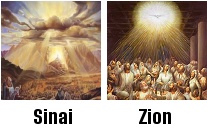|
The third month of the Jewish calendar (as reckoned from the month of Nisan) is called Sivan (ūĪų┤ūÖūĢųĖū¤), which usually begins during late May or early June. In the Torah this month is simply called "the third month" (i.e., chodesh ha-shlishi: ūŚūōųČū®ūü ūöųĘū®ų╝ūüų░ū£ų┤ūÖū®ūüų┤ūÖ), though some time after the Babylonian Captivity it assumed its present name. Sivan is mentioned only once in the Jewish Scriptures, in the post-Exillic Book of Esther (Esther 8:9).
Since Sivan always has 30 full days, Rosh Chodesh Sivan (i.e., the celebration of the new month) is observed for only one day. Among the Orthodox, the second day of Sivan is called "yom hameyuchas" (the "day of distinction"), since on this day the people agreed to accept the Torah, and upon thier ratification Moses instructed the people to prepare themselves to become "a kingdom of priests and a holy nation" (Exod. 19:6-8). In some circles this "day of distinction" is celebrated as a minor festival. On the third day of month the LORD instructed Moses to "set a boundary" (hagbalah) for the people around the mountain in preparation for the coming revelation to be given three days later (Exod. 19:9-15). These three days are called the "Three Days of Separation" (i.e., Sheloshet Yemei Hagbalah: ū®ūüų░ū£ū®ūüųČū¬ ūÖų░ū×ųĄūÖ ūöųĘūÆų╝ų░ūæų╝ųĖū£ųĖūö) during which the people prepared for the revelation to come on Sivan 6th: "Make yourselves ready by the third day" (Exod. 19:11,15). The Talmud comments: "Blessed be our God who has given a threefold Torah (Torah, Prophets, Writings) to a threefold nation (Kohanim, Levites, and Israelites) through one who was third (Moses, the third child after Aaron and Miriam) in the third month."
 |
The first five days of the month of Sivan anticipate the day that the Torah was revealed to Israel at Sinai, namely, on the sixth of Sivan, a date which the rabbis later associated with the holiday of Shavuot ("Weeks" or "Pentecost"), which occured exactly 7 weeks after the Exodus from Egypt. On the night of Shavuot itself, after celebrating the holiday meal, it is customary to read selections from the Torah (and portions of the Talmud) until sunrise. This custom is called tikkun leil shavu'ot: ū¬ų╝ų┤ū¦ų╝ūĢų╝ū¤ ū£ųĄūÖū£ ū®ūüųĖūæūĢų╝ūóūĢų╣ū¬, "Rectification for Shavuot Night," and was instituted as a "remedy" for Israel's failure to be awake on the morning of the revelation (the midrash scolds the people who overslept on the morning of the revelation and who needed to be roused by the heavenly shofar blast, loud thunder and lightning to salute the King). Spiritually speaking, then, the month of Sivan represents the giving of the Torah to Israel (i.e., z'man mattan Toratenu: ū¢ų░ū×ųĘū¤ ū×ųĘū¬ų╝ųĘū¤ ū¬ų╝ūĢų╣ū©ųĖū¬ųĄūÖūĀūĢų╝), when the drama which began with the Exodus from Egypt culminated with the giving of the Torah. For Messianic believers, the month of Sivan also commemorates the giving of the Ruach Ha-Kodesh (Holy Spirit) to the followers of Yeshua after His ascension into heaven.
 |
The commandment to sanctify the new moon of Sivan reveals that it is our responsibility to sanctify (i.e., observe) Biblical time in general. In other words, when we observe the month in which the Torah was revealed to Israel, we are acknowledging that time itself is rooted in the Biblical calendar with its divinely inspired cycle of festivals (i.e., the moedim).
The Holiday of Shavuot
|







